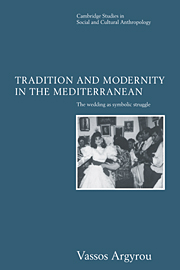Book contents
- Frontmatter
- Contents
- List of illustrations
- Acknowledgments
- Introduction
- 1 The island of Aphrodite
- 2 Nationalism and the poverty of imagination
- 3 The weddings of the 1930s
- 4 The meaning of change
- 5 Distinction and symbolic class struggle
- 6 Anthropology and the specter of “monoculture”
- 7 The dialectics of symbolic domination
- Appendix
- Notes
- References
- Index
- Cambridge Studies in Social and Cultural Anthropology
3 - The weddings of the 1930s
Published online by Cambridge University Press: 25 August 2009
- Frontmatter
- Contents
- List of illustrations
- Acknowledgments
- Introduction
- 1 The island of Aphrodite
- 2 Nationalism and the poverty of imagination
- 3 The weddings of the 1930s
- 4 The meaning of change
- 5 Distinction and symbolic class struggle
- 6 Anthropology and the specter of “monoculture”
- 7 The dialectics of symbolic domination
- Appendix
- Notes
- References
- Index
- Cambridge Studies in Social and Cultural Anthropology
Summary
Apart from those who experienced them first hand and portray them with a certain nostalgia, and the folklorist who seeks to capture the memory of a fleeting “cultural heritage” (Averof 1986:5), the wedding celebrations of the recent rural Cypriot past are considered by most people as little more than protina pramata (aboriginal things) – picturesque perhaps, but also remote, unsophisticated, and crude. These perceptions can hardly do them justice. The weddings of the 1930s were complex events – at the same time religious, social, and political – that expressed and legitimated an intricate way of life with its own visions and divisions, aspirations and dilemmas, conflicts and contradictions.
Drawing on folkloric accounts and my own fieldwork, in this chapter I will reconstruct the wedding celebrations of this period and attempt to capture a sense of what they must have been like. My primary aim, however, is to highlight certain key features and in particular the role of weddings in the legitimation and reproduction of two fundamental divisions in the social order – between the generations and among adult men. This is not to deny that weddings legitimated other divisions, such as between men and women (Skouteri-Didaskalou 1984; Kligman 1988: 74–149; Cowan 1990:87–133). Nor am I unaware that they reproduced other important institutions, such as the family, sex, and kinship. The emphasis on division and inequality is meant to render the dynamics of both change and continuity comprehensible.
- Type
- Chapter
- Information
- Tradition and Modernity in the MediterraneanThe Wedding as Symbolic Struggle, pp. 60 - 78Publisher: Cambridge University PressPrint publication year: 1996

